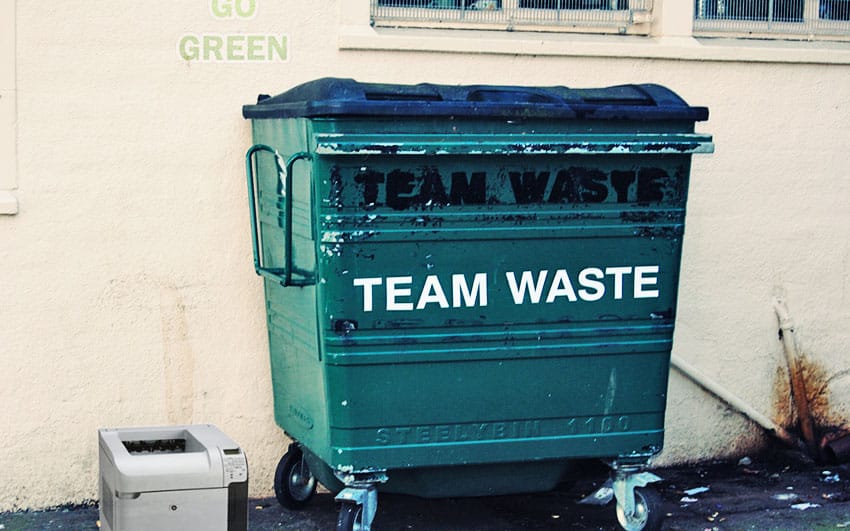The Financial Benefits of Reducing Print

Companies routinely spend millions of dollars — between 1 and 3 percent of their revenue — on the creation of paper documents. However, very few companies today measure and control this critical element of their IT spending budget. In fact, from our experience, most companies cannot estimate the number of printer and copier assets they own within 25 percent of the actual number.
Because printing costs and investments are largely invisible, most organizations have dramatically underestimated their costs and have overinvested in equipment. As a result, a huge savings opportunity exists when the right technology is in place.
Our 20 years of experience in the business have shown that the average 10,000-person firm can achieve more than $1.5 million in savings per year by implementing a strategic print optimization program. Larger organizations can save significantly higher amounts. Furthermore, many companies can easily reduce their printing costs by up to 30 percent while improving employee productivity. In different terms, it’s realistic to expect that companies can save between $360 and $600 per employee annually.
The concept of reducing print to save money and shrink a company’s ecological footprint is not new, but because most organizational leaders don’t think strategically about printing, they often don’t challenge or even measure their organizations’ printing costs and volumes.
When printing goes unchecked, it has a way of getting out of hand. Simple questions go unanswered. Do you know how much is being printed — and how much it costs? Which employees and applications are generating the most print? What is being printed, and is it all business-related?

Here are four ways you can begin to put an end to wasteful printing:
- Establish a baseline by monitoring your printing volumes and costs.
Again, many organizations don’t track their printing costs closely, if at all, so they don’t have a realistic view of what they spend on printing annually. These organizations can save a lot of money by implementing the right solution, which will reveal the hidden costs of uncontrolled printing.
Printing documents is expensive, but many employees view it as free. Seeing just how much of your budget it consumes can be eye-opening (or jaw-dropping).
But you can’t make improvements without truly understanding your current state, and to fully comprehend how much you’re spending, you need to drill down to hard numbers. This first step is remarkably easy to implement, and companies can start seeing savings almost immediately.
Having the right technology to track your enterprise-wide printing activity and costs — at the user and device levels — is essential. It also helps to partner with a print expert to explain what all the data points mean and what you can do to make improvements.
If your organization is large, the big picture can be a bit discouraging. However, the good news is that the more you’ve been wasting, the more you can start saving. And it doesn’t have to cost you anything to see this big picture.
- Create a campaign to build awareness and instill a “less print” mindset.
The most significant factor in reducing print is the people who use the equipment, not the equipment itself. When companies set out to cut printing costs, they often focus on devices and the ink and toner they consume. This is a good start, but even the most efficient equipment will be wasteful if it’s not used appropriately.
Keep in mind that devices don’t print; people do. If you’re not managing people, you’re not managing print (and you’re leaving half your savings on the table). The focus should be on the demand side, not just the device side.
People print for two reasons: because they want to (convenience) or because they have to (process). Raising employee awareness about printing and educating them on simple approaches to change can have a significant impact — especially with regard to convenience printing.
When you communicate new printing policies to employees, emphasize the positive effects that more mindful printing will have on the company’s bottom line and carbon footprint. Be sure to have managers at every level encourage their employees to “think before they print” and consider ways to print less. To drive this change, you need to arm your managers with reports that outline all printing activity and costs for their departments.
You can realize similar, if not larger, returns by reducing process-based print. But process re-engineering takes a little longer and requires additional resources — an investment that is certainly warranted from an ROI perspective.
Consider this: A company of 40,000 employees can reduce print by more than 20 million pages per year simply by having each employee reduce his or her personal printing by two pages per day. That equates to saving 2,400 trees and more than $1 million per year.
Will your employees revolt? Actually, quite the opposite. Although people often do not welcome change, my experience is that most employees are eager to assist, especially if you can make it personal to them. For example, rather than make the changes about financial savings alone, communicate benefits related to environmental sustainability. Organizing the right campaign around printing habits provides best practices and shows how each employee can contribute to creating a more mindful and sustainable organization.
- Proceed in phases.
Focus on the easiest areas first so you can start saving right away and achieve the fastest ROI. Identify opportunities that are relatively easy to address; after you’ve gone after the low-hanging fruit, you can move on to the more complex areas of print. This might be as simple as reducing print by one or two pages per day or printing less color, given that color is often five times more expensive than monochrome, if not more.
As you put your print strategy into action, understand that these initiatives take time. Your strategy should encompass all areas of print, including process and compliance workflow printing, convenience printing, in-house production printing, and even externally sourced print. We often find that the savings alone from externally sourced print can fund most, if not all, of your internal print spend.
As you move through each area of the organization, your goal should be to define your business-critical documents. This might sound obvious, but one of the pushbacks I often see in industries such as banking and financial services is the insistence that most of their print is compliance-driven. It’s critical to determine what is truly compliance-driven versus what is assumed to be. Large organizations commonly achieve much greater reductions in unnecessary printing than originally expected.
- Get senior leadership to role model and support the effort.
A nationally recognized, integrated health network with more than 40,000 employees reduced corporate printing volume by more than 40 percent and realized a positive return on investment in less than nine months. The organization was able to achieve this because it had a print strategy based on its unique goals and printing activity and because its management team leaders served as role models in the effort to reduce print and establish more mindful printing behaviors throughout the organization. Implementing print management and security technologies is only half the story.
As another example, one of the largest health insurers in the United States cut its print volume by more than 25 percent in one year. Its key success factors included a detailed print strategy, the right print management tools, a highly effective education campaign, and the consistent support of senior leadership.
A global banking and financial services company saves more than $10 million each year as a result of these print reduction initiatives. Again, the common ingredients include a data-driven print strategy, the right print management and security software, and the proactive support of senior leadership.
Even if sustainability is not your primary concern, you should care about your bottom line, and if you don’t already have a strong print strategy in place, you’re probably wasting money. By taking charge of your organization’s printing, your company can realize significant cost savings, improved operational efficiency, and sustained profitability. Maintaining such an advantage in the ever-changing workplace is critical to your organization’s success.
Written by Michael O’Leary.
******
Michael O’Leary is Vice President-Enterprise Accounts at Pharos Systems International, a print management software and solutions company based in Rochester, N.Y. With more than 30 years of experience in the technology and print industries, O’Leary leads an organization that provides expertise in software, subject matter, thought leadership, and best practices to some of the largest companies in the world.
Bring the best of the CEOWORLD magazine's global journalism to audiences in the United States and around the world. - Add CEOWORLD magazine to your Google News feed.
Follow CEOWORLD magazine headlines on: Google News, LinkedIn, Twitter, and Facebook.
Copyright 2025 The CEOWORLD magazine. All rights reserved. This material (and any extract from it) must not be copied, redistributed or placed on any website, without CEOWORLD magazine' prior written consent. For media queries, please contact: info@ceoworld.biz








